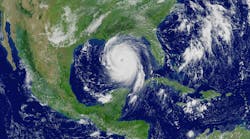Heather Towsley is vice president of market strategies for SmartCover. Towsley can be reached at [email protected].
undefinedYou know how the classic arcade game goes. A mole comes out from the hole, and you try to hit it quickly back down with your hammer so you can get to the next one before your time runs out. On it goes until you reach your high score and get your prize, but only if you connect with the moles at the right time.
The game embodies the stress of dealing with an overwhelming task on a strict time crunch. This is similar to what collection system operators have faced for ages.
As we know, the infrastructure of our cities is typically very old and vulnerable to weather conditions, especially storm water and cold temperatures. In the past, sewer operators did not have the time, resources or manpower to manage every single manhole. This leads to a peripatetic cadence as operators typically move from situation to situation each season whether that is inflow and infiltration (I&I), combined sewer overflow (CSO) or sanitary sewer overflow (SSO). Ultimately, resources are overburdened, and it truly becomes whack-a-mole.
In the past, collection system operators had no way to know what was going on underground in their pipes without lifting a lid or rolling a truck to look under the manhole cover. They also had no way of collecting and managing data to predict future maintenance or at-risk locations.
Taking Storm Water by Storm
Founded in 2005 by two elected water officials who recognized a pressing challenge related to the detection of blockages and sewer spill prevention, Dr. Greg Quist and David Drake, invented and engineered the first real-time remote sewer monitoring. It has influenced the strategies related to CSO and SSO prevention since. Their technology changed the game for sewer operators.
Instead of relying on routine cleanings and visual inspections, SmartCover enabled real-time monitoring and data collection allowing predictive analytics to help prevent sewer spills. Twenty years ago, their patented design of small, rugged, smart and accurate sensors that withstand humid and noxious sewer conditions would have cost millions and required a warehouse. The triple trend in the technological evolution spanning over the past 30 years combines an increase in storage and battery performance with decreased size, when our storm water infrastructure demands innovation.
It is no surprise that U.S. storm water infrastructure received one of the lowest grades granted by the 2021 Report Card for America’s Infrastructure, released every four years by the American Society of Civil Engineers (ASCE). The 2021 report card — the first to assess storm water infrastructure since ASCE began assigning grades in 1998 — ranks storm water infrastructure as a ‘D’ on an A-to-F scale.
Today, sophisticated algorithms and software analysis ferret out display at-risk locations and notify operators with advance warnings. This allows personnel to be prepared with preemptive measures before the next emergency happens. The data-driven analytics provided are proving to significantly reduce costs on maintenance schedules by increasing the efficiency of resource allocation and manpower deployment.
Managing the Impact of Seasonal Weather Cycles
Hundreds of cities implementing smart city technology have drastically reduced sewer spills and are more effectively managing the impact of seasonal weather cycles. Cities, such as San Antonio and Arlington in Texas and Harthorne, El Segundo, and Escondido in California, are experiencing as much as 90% decrease in overflows and saving millions in fines and/or mitigation costs. Specially patented sensor designs are able to notify responders of most critical locations, thereby increasing efficiency of asset management, pipe replacement and repairs to effectively prevent spills.
SmartCover calls this strategy ‘Sewerball’ — a method similar to the story of "Moneyball," the best-selling book by Michael Lewis and 2011 feature film starring Brad Pitt and Jonah Hill. For those of you unfamiliar with the story, "Moneyball" is about the art of winning an unfair game. It is the story of how Major League Baseball’s Oakland A's general manager Billy Beane, successfully assembled a baseball team on a lean budget by employing computer-generated analysis to acquire new players. Mr. Bean used Sabermetrics, which was defined as using analytics of baseball records to track players performance, and determine which players would be successful in the long-run. The impact of the story is that a less fortunate team with a limited budget could use data analytics to build a competitive team against comparatively better teams with unlimited resources.
Like Moneyball, a Sewerball strategy enables cities to understand the performance of their wastewater infrastructure with collection system visibility. Data sets are compared to physical models of operations and used to maximize efficiency. Predictive assessments link how externalities affect physical operations and how to adapt operationally. One of the technological advantages is the ability to rank the correlation and rank the impact of inflow happening inside a collection system.
When I&I is exacerbating a collection system, overflow risk and water treatment costs increase. The technology system automatically crunches the numbers to calculate the highest level of I&I and identifies compromised locations for targeted maintenance throughout a collection system. Analysis can distinguish wet weather flows compared to dry weather flows establishing a ratio for operators. Before smart sewer technology, these locations had to be manually inspected, creating an expensive and inefficient use of resources and manpower.
With the vision set forth by the Biden Administration’s Build Back Better, we should see public and private wastewater utilities investing in infrastructure upgrades across the U.S. As a result, storm water infrastructure projects across the country are being leveraged to support economic inclusion and community opportunities.
Making the investment to bring incredible advancements to historically under-resourced communities, we see public and private wastewater utilities becoming leaders in the goal of bettering the quality of life in communities across the country.
More and more water and wastewater utilities are understanding the role they can play as anchor institutions in communities. Many of these investments will take place in communities that have been historically under-resourced. Community infrastructure and utilities will be critical to the quality of life in our neighborhood.
Now there are faster hammers at the ready, poised to strike at the right time and the right place. Advanced monitoring systems are bringing down the hammer precisely on top of the mole. The new age of monitoring technology and data trend analysis paves the way for storm water management. The cities that understand this and seek out innovative solutions, will ultimately take the proper action to protect and improve our quality of life, and perhaps raise our future grade.






